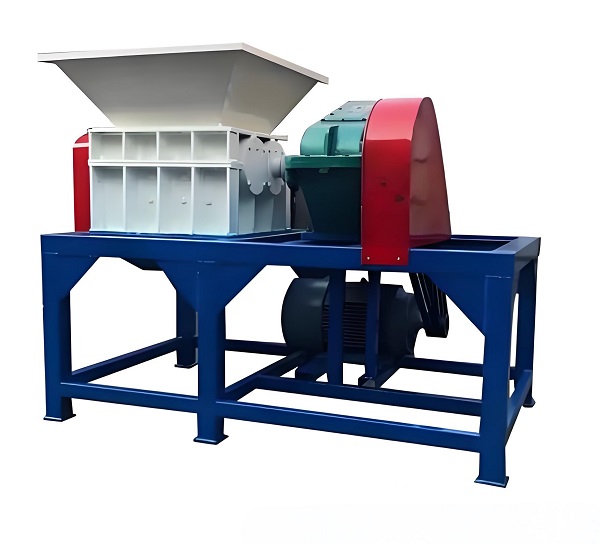
The single-shaft shredder is mainly composed of a blade spindle, a fixed blade, a bearing box and other components. It shreds the material through the tearing, squeezing and shearing action of the blade. It is suitable for a variety of waste materials such as wood, rubber, plastic, etc. It has the characteristics of high efficiency, durability, flexibility, safety, convenience, environmental protection and low noise.
As an efficient and versatile material handling equipment, the single-shaft shredder has shown wide application potential and market value in waste recycling, resource reuse and multiple industrial fields in recent years. Its unique single-shaft design not only improves the stability and durability of the equipment, but also makes it more flexible and convenient in actual operation.
The working principle of this equipment is mainly to cut, squeeze and shear the material through the protruding cutter head on the drive shaft to achieve the effect of shredding. This design makes the single-shaft shredder perform well in processing materials with strong entanglement, such as plastics, rubber, wood, paper and domestic garbage. At the same time, the use and maintenance costs of its cutters are relatively low, and the replacement of cutters is also convenient and quick, which further improves the economy and practicality of the equipment.
The single-shaft shredder is mainly composed of a drive shaft, a cutter head, a body, a motor and a control system. The core lies in the cutter heads protruding from the drive shaft. These cutter heads are specially designed with excellent cutting, squeezing and shearing performance. When the motor is started, the drive shaft drives the cutter head to rotate at high speed, thereby powerfully crushing the input materials.
The working principle of this equipment is based on the compound action of shearing, extrusion and cutting. After the material is put into the equipment, it is captured by the cutter head and brought into the crushing area. As the cutter head rotates, the material is subjected to strong shearing and extrusion, and is finally cut into smaller particles or fragments. This crushing method is not only efficient, but also can handle a variety of materials, such as plastics, rubber, wood, paper, and domestic waste.
In terms of application areas, single-shaft shredders are widely used in many fields such as plastic recycling, rubber recycling, wood processing, and domestic waste treatment. By crushing waste into smaller particles or fragments, it can be easily classified, recycled and processed, thereby improving the utilization rate of resources. In addition, the single-shaft shredder also has the advantages of low energy consumption, low noise and small footprint, making it more convenient and efficient in practical applications.
The single-shaft shredder has shown a wide range of application prospects in many fields. In the field of plastic recycling, it can crush waste plastic products into smaller particles for subsequent melting and regeneration. In the field of rubber recycling, the single-shaft shredder can crush waste rubber products into fragments for the production of rubber particles or rubber powder. In addition, single-shaft shredders also play an important role in the fields of wood processing, paper recycling, and domestic waste treatment.
The advantages of this equipment are that it is efficient, stable, durable and easy to maintain. The single-shaft design makes the equipment more stable during operation and reduces the frequency of failures and repairs. At the same time, the cutter head is made of high-strength material, which has excellent wear resistance and impact resistance, extending the service life of the equipment. In addition, the single-shaft shredder also has the advantages of low energy consumption, low noise and small footprint, making it more convenient and efficient in practical applications.
With the continuous improvement of environmental awareness and the emphasis on resource recycling, the market demand for single-shaft shredders continues to grow. More and more companies and individuals have begun to pay attention to this efficient material handling equipment, hoping to reduce production costs, improve resource utilization and reduce environmental pollution by using single-shaft shredders. In the future, with the continuous advancement of technology and the continuous expansion of the market, single-shaft shredders are expected to be used in more fields, showing a broader market prospect.
Single-shaft shredders play an important role in the field of material handling with their advantages of high efficiency, stability, durability and easy maintenance. In the future, with the continuous growth of market demand and the continuous innovation of technology, single-shaft shredders are expected to provide more efficient and environmentally friendly material handling solutions for more fields. With the continuous improvement of environmental awareness and the emphasis on resource recycling, the market demand for single-shaft shredders continues to grow. More and more companies and individuals are beginning to pay attention to this efficient shredding equipment, hoping to reduce production costs, improve resource utilization and reduce environmental pollution by using single-shaft shredders.
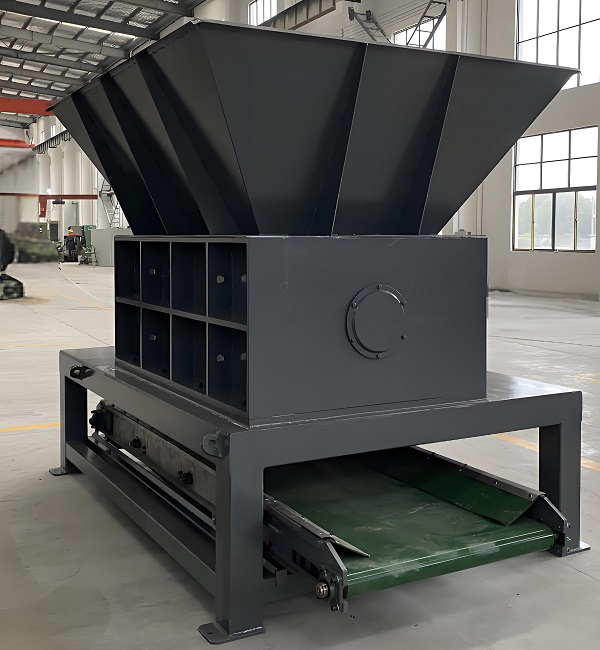
1. Match the crushing effect with the material range: When purchasing a single-shaft shredder, first confirm whether the crushing effect of the equipment can meet the production requirements, and understand the range of materials that the shredder can handle to ensure that it can handle the type of materials that need to be crushed.
2. Consider core configuration and quality: The core configuration of the shredder is crucial to its service life and performance. High configuration usually means higher price, longer service life and lower failure rate, while low configuration may lead to frequent failures and shorter equipment life. Therefore, it is necessary to carefully compare the configuration and quality of different products when purchasing.
3. Consider price rationality: Price is not the only criterion for choosing a shredder, but it is still an important consideration. When purchasing, be wary of high-end configuration products with abnormally low prices, as this may be a trap for merchants to sell inferior products as good ones. A reasonable price should reflect the true value and cost of the product.
4. After-sales service: Professional shredder manufacturers usually provide a complete after-sales service system that can quickly and accurately solve various problems encountered by users during use. Before purchasing, it is necessary to confirm whether the manufacturer's after-sales service items and technical guidance are complete to ensure that the subsequent use of the equipment is guaranteed.
5. Understand the manufacturer's strength and inspection: When purchasing a shredder, it is recommended to conduct an on-site inspection of the manufacturer's scale and production capacity. Through on-site testing, you can intuitively understand the actual effect of the equipment in processing materials and evaluate the manufacturer's technical strength and professionalism. This helps to avoid purchasing equipment that is of poor quality or does not meet production needs.
6. Pay attention to product updates and iterations: Considering the speed of product updates and iterations, you should pay attention to the advancement of the shredder's design, knives, and electrical aspects when purchasing. Choosing equipment that uses new technologies and new materials can ensure that it maintains high production efficiency and competitiveness for some time to come. When purchasing a single-shaft shredder, you need to consider multiple aspects, including crushing effect, core configuration, price rationality, after-sales service, manufacturer strength, and product updates and iterations. By comprehensively evaluating these factors, you can ensure that you purchase equipment that meets production needs, has stable performance, and is cost-effective.
The high quality of the single-shaft shredder is reflected in its powerful crushing capacity, high operating efficiency, durable structural design and excellent adaptability. It is made of high-quality materials, durable, and can handle a variety of materials of different hardness and size. At the same time, the equipment is easy to operate, has low maintenance costs, and meets environmental protection standards. It is an ideal choice for waste treatment and resource recovery.
It can be flexibly designed according to the specific needs of customers. Whether it is processing materials of different materials and sizes, or adapting to a specific production environment, the single-shaft shredder can achieve precise matching by adjusting parameters such as the cutter, power, and feed port size, thereby improving production efficiency, reducing operating costs, and meeting the diverse needs of customers.
The high performance of the single-shaft shredder lies in its powerful crushing capacity, high operating efficiency and excellent durability. It can quickly and accurately process various materials and crush them into the required particle size. At the same time, the equipment has stable operation, low failure rate, simple maintenance, and is equipped with an intelligent control system, which is easy to operate. It is an ideal choice for improving production efficiency and reducing energy consumption.
The single-shaft shredder's powerful crushing capacity can easily handle a variety of hard materials; the design structure is compact, space-saving, and flexible to operate; the cutter is wear-resistant and durable, reducing maintenance costs; it is equipped with safety protection devices to ensure safe operation; the intelligent control system is simple and convenient to operate; it is highly efficient and energy-saving, meets environmental protection standards, and promotes green production.
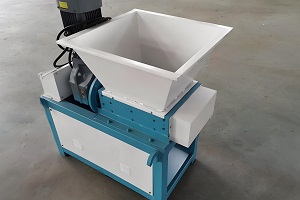
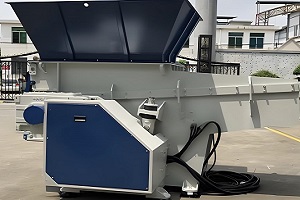
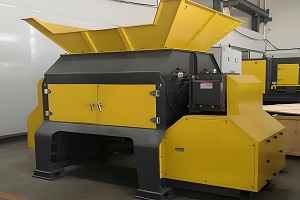
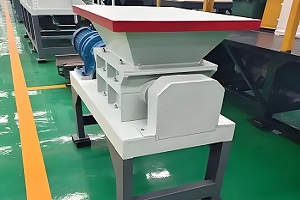
The working principle of a single-shaft shredder is relatively intuitive and efficient. Its core lies in the shredding of materials through the rotational force of a single shaft. The following is an overview of the working principle of a single-shaft shredder:
The single-shaft shredder mainly relies on "hydraulic pushing" and "roller crushing" to shred materials. Waste materials first enter the shredding box through the feeding system. In the box, there are moving blade rollers and fixed blades, which together constitute the key components of shredding. When the material enters the box, the oil cylinder pushes the pusher box to push the material evenly near the blade. At this time, the reduction motor starts to work and drives the moving blade roller to rotate.
The rotation of the moving blade roller causes the blade to scrape, tear, squeeze and shear the material. The combined application of these forces causes the material to be gradually shredded into small pieces. With the continuous rotation of the blade and the continuous entry of the material, the shredding process can be carried out continuously. Finally, small pieces of material that reach the specified size are discharged from the box through the sieve holes, completing the entire shredding process.
The working principle of a single-shaft shredder is a complex but efficient process that relies on the synergy of multiple components to effectively shred large pieces of material into small pieces. The following is a detailed overview of the working principle of a single-shaft shredder:
1. Core components and functions
Spindle and blade:
The core component of a single-shaft shredder is the spindle, which is usually driven by a motor and a reducer and rotates at a certain speed.
The blade is mounted on the spindle and rotates with the rotation of the spindle. The blade is usually designed with a sharp edge for cutting materials.
The blade is divided into a rotating blade and a fixed blade. The rotating blade rotates with the spindle, and the fixed blade is fixed on the box body. The two cooperate to form a shearing effect.
Box and fixed blade:
The box body is the main structure of the single-shaft shredder. It carries components such as the spindle, blade, feed port and discharge port.
The fixed blade is installed on the inner wall of the box body or a specific position, forming a certain angle with the rotating blade to assist in cutting and tearing materials.
Feeding and discharging system:
The feeding system usually includes a large feed port for feeding the material to be processed into the box.
The discharging system is usually located at the bottom or side of the box to discharge the shredded material.
2. Working principle process
Material entry:
The material to be processed is fed into the shredding box through the feed port.
Blade cutting:
When the material enters the box, the rotating blade begins to interact with the fixed blade to cut the material.
The sharp edge and high-speed rotation of the blade allow the material to be quickly cut into smaller pieces.
Extrusion and tearing:
In addition to cutting, the blade further processes the material by extrusion and tearing.
The special design of the blade and the shape of the box make the material subject to strong extrusion and tearing while being cut.
Material discharge:
The shredded material is discharged from the box through the discharge port for subsequent reuse or treatment.
The working principle of the single-shaft shredder enables it to efficiently shred large pieces of waste materials into small pieces, which is convenient for subsequent transportation and reuse. This equipment is widely used in the recycling and processing of waste plastics, wood, rubber, paper and other materials, providing strong support for resource recycling and environmental protection.
With its unique working principle and efficient shredding ability, the single-shaft shredder plays an important role in the field of waste material recycling and processing. Through continuous technological innovation and optimization, the performance and efficiency of the single-shaft shredder will be further improved, making greater contributions to environmental protection.

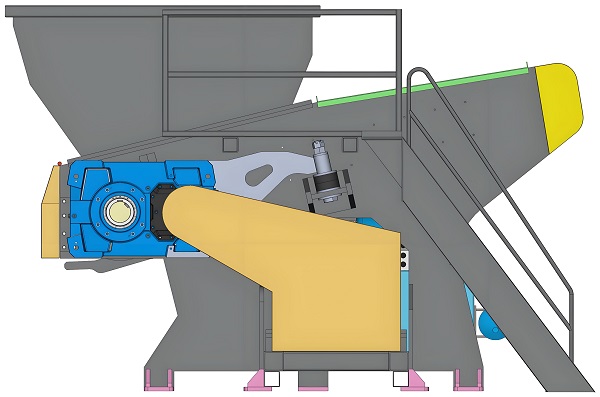
| Model | Overall dimensions (L×W×H, mm) | Hopper opening (L×W, mm) | Discharging height (mm) | Pushing stroke (mm) | Slewing diameter (mm) | Rotor length (mm) | Speed (rpm) | Standard screen aperture (mm) | Number of moving knives (PCS) | Number of fixed knives (PCS) | Motor power (Kw) | Hydraulic station power (Kw) | Hopper volume (L) | Weight (Kg) |
|---|---|---|---|---|---|---|---|---|---|---|---|---|---|---|
| V500 | 1780×1190×1690 | 790×500 | 447 | 500 | Ø220 | 500 | 80 | Ø40 | 19 | 4 | 15 | 1.5 | 660 | Approx 1500 |
| V600 | 1780×1290×1690 | 790×600 | 447 | 600 | Ø220 | 600 | 80 | Ø40 | 23 | 4 | 18.5 | 1.5 | 760 | Approx 1650 |
| V800 | 2670×1760×2090 | 1300×800 | 565 | 815 | Ø400 | 800 | 80 | Ø40 | 35 | 4 | 37 | 2.2 | 1500 | Approx 3650 |
| V1000 | 2670×1960×2090 | 1300×1000 | 565 | 815 | Ø400 | 1000 | 80 | Ø40 | 45 | 4 | 45 | 2.2 | 1760 | Approx 4250 |
| V1200 | 2670×2500×2090 | 1300×1200 | 565 | 815 | Ø400 | 1200 | 80 | Ø40 | 55 | 6 | 55 | 5.5 | 2030 | Approx 5050 |
| V1500 | 2670×2810×2140 | 1300×1500 | 615 | 815 | Ø400 | 1500 | 80 | Ø40 | 70 | 6 | 75 | 5.5 | 2430 | Approx 6300 |
*The output will vary according to different materials, feed particle size and other factors.
Save Time! Get A Detailed Quotation Quickly.
